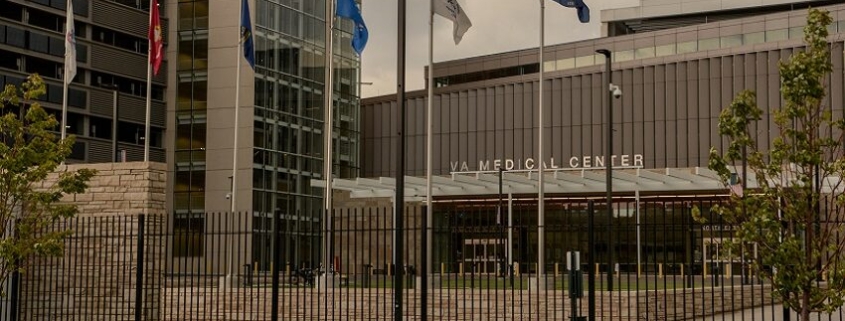When the U.S. Veterans Affairs medical complex in Aurora finally opened, a decade behind schedule and more than $1 billion over its initial budget, it was already the most expensive VA hospital in the country.
Three years later, costs to get the 11-building, 1.2 million-square-foot, 31-acre medical campus operating have grown by another $40 million — pushing the total tab to more than $2 billion and putting it among the costliest health care facilities in the world. Only the $2.4 billion Royal Adelaide Hospital in Australia is more expensive, according to Emporis, which tracks construction projects worldwide.
A Denver Post review of spending projects since 2018 found piecemeal additions of multi-million-dollar projects that were initially canceled to keep the price tag down — a new $20 million PTSD building among them. Millions more was spent on a litany of malfunctioning, poorly installed, or missing items that were muffed from the start.
Failed sewers, broiling elevators, downspouts spewing hazardous liquid, improper fire doors, and sidewalks without handicap-accessible curbing were a handful of the items that needed to be fixed or reworked, according to records and interviews. Had VA officials not backed away from another $100 million in proposed additions of several items that had been lopped off the original plan, the Aurora facility would easily have become the priciest ever.
“Sadly, I don’t think all the extra money will ever get anyone’s attention,” said Richard Tremaine, the former associate director for VA’s Eastern Colorado system who helped oversee the hospital’s activation. “If you look at all the things that were cut out … you’ll see how they bare-boned the facility and the taxpayer still way overpaid for that hospital.”
The new Rocky Mountain Regional VA Medical Center doubled the size of the aging and crumbling VA hospital in downtown Denver, but the actual costs of moving the entire operation to the former Fitzsimons Army Base just off Interstate 225 next to Children’s Hospital – and dismantling the old complex – have mushroomed into a financial quagmire, according to records and interviews.
Officially called Project Eagle, employees and other agency officials labeled the ensuing efforts to finish the job as Project Phoenix.
The VA told The Post that direct construction costs at the facility — including design, security, and asbestos cleanup — exceeded $1.7 billion when it opened in 2018. VA records show the cost to fill the hospital with the necessary equipment was another $345 million.
Documents The Post acquired through open-records requests show the costs to fix or replace failed items tallied nearly $20 million more.
“It didn’t need to be this way,” Tremaine said. “But it turned out that way because of one problem after the next that needed to be fixed or tacking on things later that came from different budget places. Pinning down a precise accounting is difficult at best.”
The VA says it doesn’t add the dollars together in a one-lump sum, instead piecemealing it because they come from different contracts and budgets. That means repairs to shoddy workmanship, for instance, are separate, as are any additional buildings that might have been part of the original design but built later.
“The addition of other structures or modifications after the facility was initially built fall under separate contracts and funding as well and take into account a design, planning, additional permits, etc.,” VA spokeswoman Susan Carter wrote The Post.
U.S. Rep. Jason Crow, D-Aurora, represents the district where the VA complex is located. The former Army Ranger who served three tours in Iraq and Afghanistan said he’s dismayed by how expensive the whole project has become.
“I’ve been frustrated for years by the cost overruns, delays, and well-documented mismanagement of the construction of the Rocky Mountain VA,” Crow said in a statement to The Post. “As a veterans advocate, I pushed the VA to build the facility years ago and fix the problems. As a member of Congress, I’ll continue to conduct oversight and ensure our veterans and their families get the world-class care they deserve. That is America’s sacred promise to our veterans.”
The facility has had a troubled financial history dating back more than a decade. The entire project spanned four presidencies Its initial price tag was $600 million. When the price exploded to $1.675 billion by 2016, Congressional hearings were held and investigations conducted.
“What is most upsetting about this entire fiasco is the lack of outrage expressed by VA officials over the incredible waste of tax dollars that could have gone to providing care for our veterans and that the VA officials that were responsible for this mess were never fired for their gross incompetence,” said Aurora Mayor Mike Coffman, a former congressman who successfully battled to get the agency removed from future major construction projects. “I contacted the FBI, who has a section that investigates government corruption, and they took up an investigation, but they didn’t find anything other than a culture of incompetence in VA construction management.”
In November 2019, the U.S. House of Representatives passed H.R. 3996, which changes how mega-construction projects such as this are to be handled. It’s been awaiting attention by the U.S. Senate ever since.
The U.S. Army Corps of Engineers took over construction management from the VA in 2016 and lopped items off the plan to keep the costs from spiraling even further out of control.They included a $45 million community living center for veterans, a $20 million state-of-the-art solar system to power the facility, $1.3 million in fancy glass-etched signage, a post-traumatic stress disorder facility, and a roof-top greenhouse to filter rainwater.
Then even smaller bits were snipped away or reduced: landscape features, concrete sealers, wheelchair-accessible sidewalks, a lab for prosthetic work, ventilation in elevators.
“In order to get the appropriations approved to cover the cost overruns of the project, the VA had to cut some of the facilities related to the care of veterans with the understanding that they could be added in later which ultimately reflects the staggering true cost of the project,” Coffman said.
Any savings, however, were quickly eaten up by the costs to outfit the new hospital, the result of a multi-year lag in construction. Since the new facility was a replacement, the equipment that actually filled the old hospital was simply to be moved to the new one.That became difficult when the aging gear was too out of date to be used efficiently and had to be replaced. The new gear was, as would be expected, expensive.
“It was pretty obvious from day one that things were so screwed up,” Tremaine said. “And I think the more that got spent, the more screwed up it became.”
Tremaine said he estimated the VA spent another $785 million outfitting the complex and fixing its problems — catapulting the total cost to more than $2.5 billion — but The Post could not confirm that amount. The Post spoke with several current and former VA officials who provided details about the project’s completion and its costs but they refused to be identified publicly because they feared retaliation. Problems at the facility were evident even before it could open. Fire doors were installed badly or, in some cases, fire exits didn’t exist behind signs that said there should be one. Glass barriers between buildings didn’t line up properly.
“The fire doors issue was only the tip of the additional cost story,” Tremaine said. “The disasters from poor workmanship and the costs of all the extras and special projects just kept on coming.”
The VA spent an additional $213,000 just to be sure the facility could pass an inspection by the Joint Commission on hospital standards so it could open, records show. Within weeks of opening, however, bits of the project were already failing or had been poorly conceived. All proved costly to fix, according to three people familiar with the problems. Rainwater that was to be filtered by rooftop greenhouses ran untouched toward nearby Sand Creek without any stormwater mitigation. When a malfunctioning rooftop generator began spewing diesel fuel, workers scrambled to contain it.
“It was literally coming down the downspouts,” said a former VA official who witnessed the incident. “That’s when we caught it.”
Southern-facing glass elevators on the visitor parking garages were without ventilation, turning them into “little hothouses” in the spring and summer with temperatures that frequently hit 105 degrees, one worker said. The cost to cool them down: $69,000.
A sewage line failed after it was plugged by flushable wipes that weren’t actually flushable. Dozens of toilets had to be retrofitted with special catches to prevent the wipes from getting into the system. The costs: nearly $200,000.
Sometimes it was the general layout of the building that proved inefficient. The space for administrative workers handling billing was too small, forcing them into rented spaces. A proposal to build a new $74 million structure just for administration has been shelved.
The magnetic resonance imaging area was so cramped that technicians operating the two machines shared a control room that put them shoulder-to-shoulder, their chairs touching. The center’s sole prosthetic unit turned out to be just 150 square feet, which included a bathroom. And a research building flooded because the flashing on the outer walls was installed backward.
“There were just so many things that were built for a hotel, not a hospital,” Tremaine said. “The costs needed to fix it all was just one thing after another, constantly spending.”
In all, the costs to fix nearly three dozen problems – a list that is by no means complete – has topped $14 million, according to VA records provided to The Post.
One of the troubling items that can’t be fixed is the distance veterans must cover from the parking garages at the north end of the complex to any of the medical areas to the south. The long showcase glass corridor that is the signature spine to the structure, with several buildings attached to either side of it, is precisely 500 steps from one end to the other — roughly 300 yards. The gift shop is on one end, the main cafeteria on the other.
“That doesn’t sound like a long way, but when your feet are bad, you can’t lean into that cane very much or whatever else is hurting, even 10 steps is a long way,” said 73-year-old Carlos Aquino, a Vietnam veteran visiting the hospital recently to see a friend. “It’s a beautiful place, but sometimes it just doesn’t make a lot of sense.”
A new PTSD ward is being constructed to the north of the parking garages, likely at a cost that will touch $20 million. At some point, several other projects that were once included in the overall design but later cut might be reinvigorated – at a much higher price than their initial estimates, according to interviews.
Despite the cost overruns, delays, and additional expenses, Rep. Ed Perlmutter, D-Arvada, a longtime critic of the project’s persistent overspending, said veterans have benefitted.
“Certainly there were issues and $2 billion is a huge price tag, but was it worth it to provide our veterans the best possible health care? You bet,” Perimutter said. “In the end, we got it done which was the right thing to do to ensure the veterans of the Rocky Mountain region have access to the high-quality healthcare they need and deserve.”
For his money, Coffman said taxpayers also benefitted because the VA can’t “mismanage any more hospital construction projects.” From the VA’s point of view, veterans have a facility to be proud of.
“Many veterans who decide to stay in the area … and receive care at VA in eastern Colorado are facing increasingly complex health care needs which is one reason RMRVAMC was constructed,” VA spokeswoman Carter wrote The Post. “The center provides state of the art care … to include advanced treatment for spinal cord injury, women’s health care and inpatient treatment for a variety of ailments in a healing environment made up of all private patient rooms.”
Source: The Denver Post




